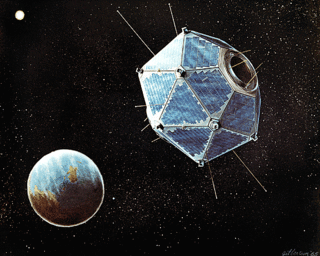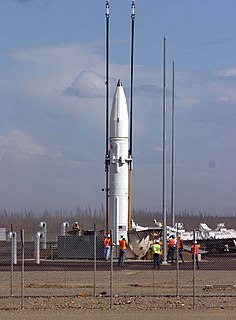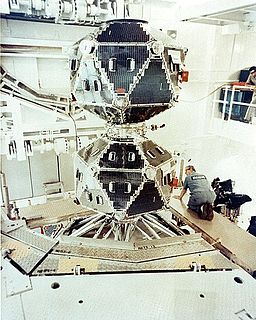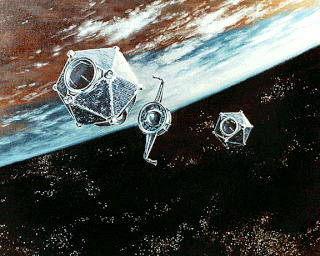TRW Inc., was an American corporation involved in a variety of businesses, mainly aerospace, automotive, and credit reporting. It was a pioneer in multiple fields including electronic components, integrated circuits, computers, software and systems engineering. TRW built many spacecraft, including Pioneer 1, Pioneer 10, and several space-based observatories. It was #57 on the 1986 Fortune 500 list, and had 122,258 employees. The company was called Thompson Ramo Wooldridge Inc., after the 1958 merger of the Ramo-Wooldridge Corporation and Thompson Products. This was later shortened to TRW.
Vela or Velas may refer to:

Vela was the name of a group of satellites developed as the Vela Hotel element of Project Vela by the United States to detect nuclear detonations to monitor compliance with the 1963 Partial Test Ban Treaty by the Soviet Union.

Project Vela was a project undertaken by the United States Department of Defense to develop and implement methods to monitor compliance with the 1963 Partial Test Ban Treaty. This treaty banned the testing of nuclear weapons in the atmosphere, in outer space, and underwater, effectively meaning nuclear tests were only to be permitted underground.
A bhangmeter is a non-imaging radiometer installed on reconnaissance and navigation satellites to detect atmospheric nuclear detonations and determine the yield of the nuclear weapon. They are also installed on some armored fighting vehicles, in particular NBC reconnaissance vehicles, in order to help detect, localise and analyse tactical nuclear detonations. They are often used alongside pressure and sound sensors in this role in addition to standard radiation sensors. Some nuclear bunkers and military facilities may also be equipped with such sensors alongside seismic event detectors.
The Vela incident was an unidentified double flash of light detected by an American Vela Hotel satellite on 22 September 1979 near the South African territory of Prince Edward Islands in the Indian Ocean, roughly midway between Africa and Antarctica. Today, most independent researchers believe that the flash was caused by a nuclear explosion—an undeclared joint nuclear test carried out by South Africa and Israel.

The militarisation of space involves the placement and development of weaponry and military technology in outer space. The early exploration of space in the mid-20th century had, in part, a military motivation, as the United States and the Soviet Union used it as an opportunity to demonstrate ballistic-missile technology and other technologies having the potential for military application. Outer space has since been used as an operating location for military spacecraft such as imaging and communications satellites, and some ballistic missiles pass through outer space during their flight. As of 2018, known deployments of weapons stationed in space include only the Almaz space-station armament and pistols such as the TP-82 Cosmonaut survival pistol.

Hakucho was Japan's first X-ray astronomy satellite, developed by the Institute of Space and Aeronautical Science. It was launched from the Kagoshima Space Center by the ISAS M-3C rocket on the M-3C-4 mission on February 21, 1979 and reentered the atmosphere on April 15, 1985.
The history of gamma-ray began with the serendipitous detection of a gamma-ray burst (GRB) on July 2, 1967, by the U.S. Vela satellites. After these satellites detected fifteen other GRBs, Ray Klebesadel of the Los Alamos National Laboratory published the first paper on the subject, Observations of Gamma-Ray Bursts of Cosmic Origin. As more and more research was done on these mysterious events, hundreds of models were developed in an attempt to explain their origins.

An X-ray astronomy satellite studies X-ray emissions from celestial objects, as part of a branch of space science known as X-ray astronomy. Satellites are needed because X-radiation is absorbed by the Earth's atmosphere, so instruments to detect X-rays must be taken to high altitude by balloons, sounding rockets, and satellites.
A nuclear detonation detection system (NDDS) is a device or a series of devices that are able to indicate, and pinpoint a nuclear explosion has occurred as well as the direction of the explosion. The main purpose of these devices or systems was to verify compliance of countries that signed nuclear treaties such as the Partial Test Ban treaty of 1963 (PTBT) and the Treaty of Tlatelolco.

Vela 1B was a military satellite developed to detect nuclear detonations to monitor compliance with the 1963 Partial Test Ban Treaty by the Soviet Union.

Vela 2A, also known as Vela 3, Vela Hotel 3 and OPS 3662, was a U.S. military satellite developed to detect nuclear detonations to monitor compliance with the 1963 Partial Test Ban Treaty by the Soviet Union. The secondary task of the ship was space research.

Vela 2B was a U.S. reconnaissance satellite for detecting explosions and nuclear tests on land and in space, the first of the second pair of Vela series satellites, taken together with Vela 2A and ERS 13 satellites. The secondary task of the ship was space research.

Vela 3A was a U.S. reconnaissance satellite to detect explosions and nuclear tests on land and in space; the first of the third pair of Vela series satellites; taken together with Vela 3B and ERS 17 satellites.

Vela 3B was a U.S. reconnaissance satellite to detect explosions and nuclear tests on land and in space; the first of the third pair of Vela series satellites; taken together with Vela 3A and ERS 17 satellites.
Vela 4A was an American reconnaissance satellite to detect explosions and nuclear tests on land and in space. It was released together with Vela 4B, ERS 18, OV5 1 and OV5 3.
Vela 4B was an American reconnaissance satellite to detect explosions and nuclear tests on land and in space. It was released together with Vela 4A, ERS 18, OV5 1 and OV5 3.

Vela 5A was an American reconnaissance satellite to detect explosions and nuclear tests on land and in space. It was released together with Vela 5B, OV5 5, OV5 6 and OV5 9.

The Environmental Research Satellite program was a series of small satellites initially operated by the United States Air Force Office of Aerospace Research. Designed to be launched "piggyback" to other satellites during launch, detaching once in orbit, they were the smallest satellites launched to date—what would today be classified as microsatellites. 33 ERS satellites in six different series were launched between 1962 and 1971, conducting scientific research and serving as test beds to investigate the reliability of new spacecraft components.








